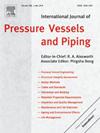Influence of internal and external hydraulic pressures on torsional resistance of steel-concrete double skin composite tubes
IF 3
2区 工程技术
Q2 ENGINEERING, MECHANICAL
International Journal of Pressure Vessels and Piping
Pub Date : 2024-12-24
DOI:10.1016/j.ijpvp.2024.105424
引用次数: 0
Abstract
In contrast to onshore engineering, the application of steel-concrete double skin composite tubes in deep-sea oil and gas pipelines involves exposure to high external hydrostatic pressure and internal hydrocarbon pressure. The composite effect under dual hydrostatic pressures exhibits unique characteristics distinct from those observed in terrestrial structures. The applicability of traditional land-based engineering design method to deep-water engineering remains uncertain. Therefore, this paper investigated the influence of dual hydraulic pressures on torsional behavior of concrete-filled double skin steel tubular (CFDST) members. The verified finite element (FE) model was employed to reveal the full-range torsional mechanism induced by hydraulic pressures. The mechanism analysis influenced by dual hydraulic pressures indicates that the existing pressures significantly enhance the confinement interactions between the double-skin steel tubes and the concrete, leading to an increased torsional resistance to the entire CFDST member. Subsequently, effects of material strengths of outer tube (fyo), inner tube (fyi) and concrete (fc), diameter-to-thickness ratios of outer (Do/to) and inner tubes (Di/ti), hollow ratios (χ), water depth (H) and internal pressure (p3) are examined through parametric study, which reflects that higher hydraulic pressure will reduce the capacity of CFDST members with large hollow ratios, e.g., the capacity of χ = 0.867 versus that of χ = 0.714 at water depth H = 3200 m, and the internal pressure has a slight effect on the torsional performance. A new calculation approach for evaluating torsional resistance is introduced, integrating the effects of external and internal hydrostatic pressures, thereby informing the application and structural design of steel-concrete double skin composite tubes in subsea engineering.
求助全文
约1分钟内获得全文
求助全文
来源期刊
CiteScore
5.30
自引率
13.30%
发文量
208
审稿时长
17 months
期刊介绍:
Pressure vessel engineering technology is of importance in many branches of industry. This journal publishes the latest research results and related information on all its associated aspects, with particular emphasis on the structural integrity assessment, maintenance and life extension of pressurised process engineering plants.
The anticipated coverage of the International Journal of Pressure Vessels and Piping ranges from simple mass-produced pressure vessels to large custom-built vessels and tanks. Pressure vessels technology is a developing field, and contributions on the following topics will therefore be welcome:
• Pressure vessel engineering
• Structural integrity assessment
• Design methods
• Codes and standards
• Fabrication and welding
• Materials properties requirements
• Inspection and quality management
• Maintenance and life extension
• Ageing and environmental effects
• Life management
Of particular importance are papers covering aspects of significant practical application which could lead to major improvements in economy, reliability and useful life. While most accepted papers represent the results of original applied research, critical reviews of topical interest by world-leading experts will also appear from time to time.
International Journal of Pressure Vessels and Piping is indispensable reading for engineering professionals involved in the energy, petrochemicals, process plant, transport, aerospace and related industries; for manufacturers of pressure vessels and ancillary equipment; and for academics pursuing research in these areas.

 求助内容:
求助内容: 应助结果提醒方式:
应助结果提醒方式:


